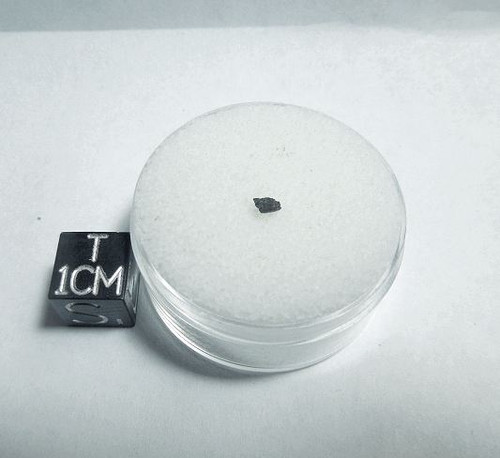Al-Haggounia 001 is a meteorite that was discovered as part of a massive impact that took place before the Saharan region was a desert. Al-Haggounia is tens of thousands of years old, and was found as part of an ancient dry river bed. It is an odd meteorite that defied classification at first. It contains very little metal, and was first classified as an aubrite. Subsequent studies showed the Al-Haggounia was not an aubrite, but was a rare EL3 enstatite chondrite. Al-Haggounia 001 has a characteristic tan matrix that consists almost entirely of tiny pure enstatite crystals. There are also occasional veins, clasts and rare chondrules. Due to it's great terrestrial age, Al-Haggounia has undergone extensive weathering and is sometimes referred to as a "fossil meteorite".
Refer to the photo. The black centimeter cube is shown for scale and is not included. You are purchasing a single small fragment like the one shown. Your purchase will include a labeled gemjar for safe storage.
Please note, the Meteoritical Society bulletin quoted below is erroneous - it is still listed as an aubrite in the official listing. But, the new studies have shown it to be an EL-Melt Rock. Otherwise the information is correct and is provided for historical and geographical context.
From the Meteoritical Society Bulletin Entry on Al-Haggounia 001 -
Al Haggounia 001 N27°30',W12°30'
Al Haggounia, Morocco
Find: 2006
Achondrite (aubrite)
History: Several tons of this material have been found on the ground or by digging near Al Haggounia, Morocco (Chennaoui et al. 2007) for description of the strewn field) and sold to several dealers. The coordinates are given for the center of the strewn field, which extends ~ 40 km.
Physical characteristics: It is impossible to assess precisely the amount of material already (and to be) recovered, but according to dealers, collectors, and Jambon it is about 3 metric tons composing many samples of varied sizes (from a few g to 50 kg). The largest stones were recovered after excavating them from the ground. The outer surface is rusty brown due to severe alteration. Looks like a sedimentary breccia cemented by iron oxide and carbonate. Color changes from bluish gray to rusty brown closest to the fractures are observed. Yellow patches of sulfur (alteration) are widespread. The rocks are significantly porous with pore sizes from several cm to hundreds of microns.
Petrography: (A. Jambon, O. Boudouma and D. Badia. UPVI) Dominated by enstatite and plagioclase. Troilite, graphite daubreelite, oldhamite, kamacite rich in Si and schreibersite are present.
Mineral compositions: Enstatite (En98Fs1Wo1) and plagioclase (Ab78An16Or5).
Classification: Achondrite (aubrite); extensive weathering. Similar to and likely paired with NWA 002, 1067, 2736, 2828, 2965.
Type specimens: A total of 50 g of sample and three polished sections are on deposit at UPVI.
Main masses: Beroud, 3886 g (26 pieces from 1185 g to 5.8 g); PThomas, 4497 g (33 pieces from 11 to 1507 g); Hmani, about 500 kg; Ouzrou, about 500 kg.





